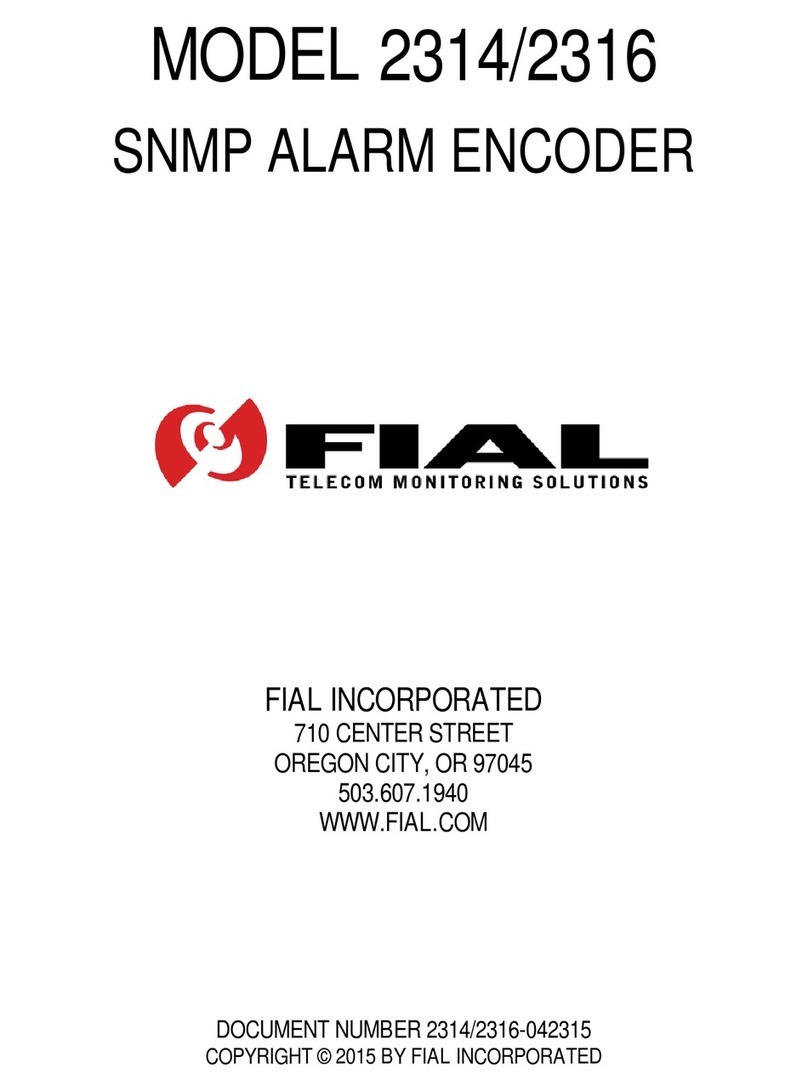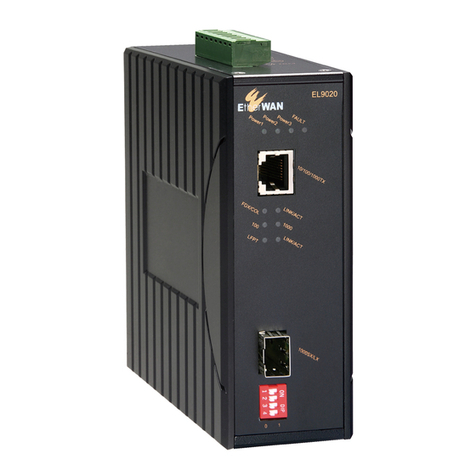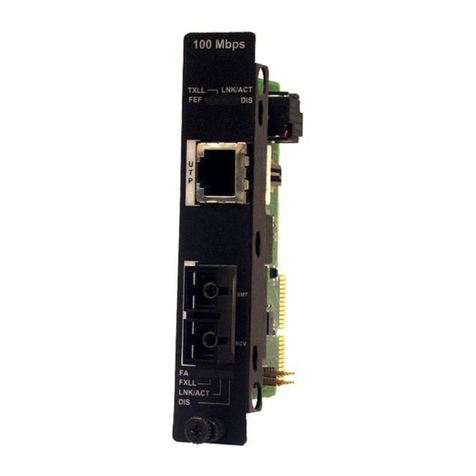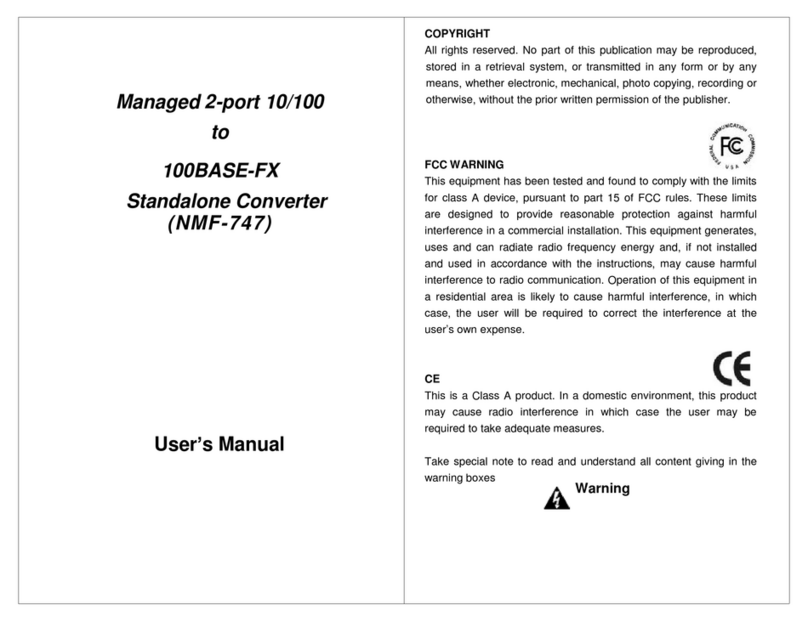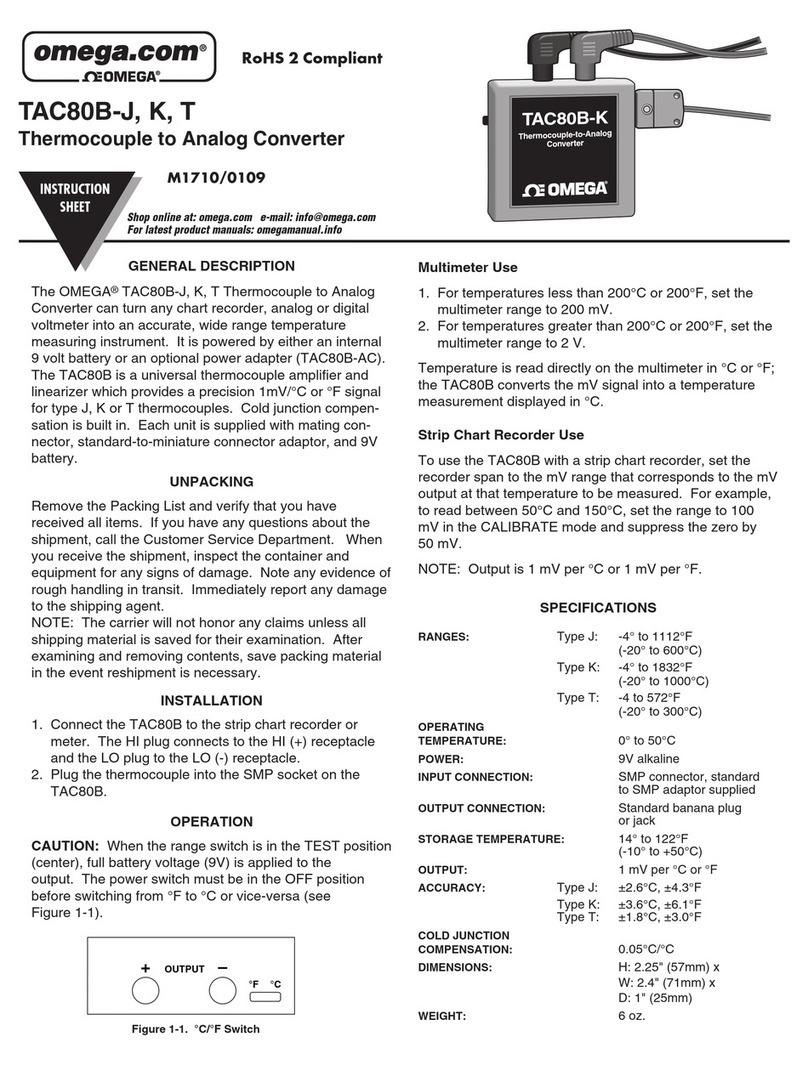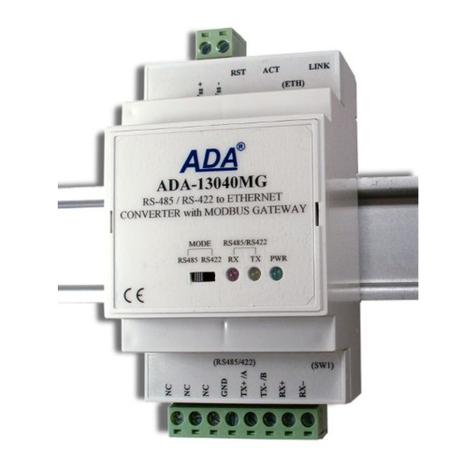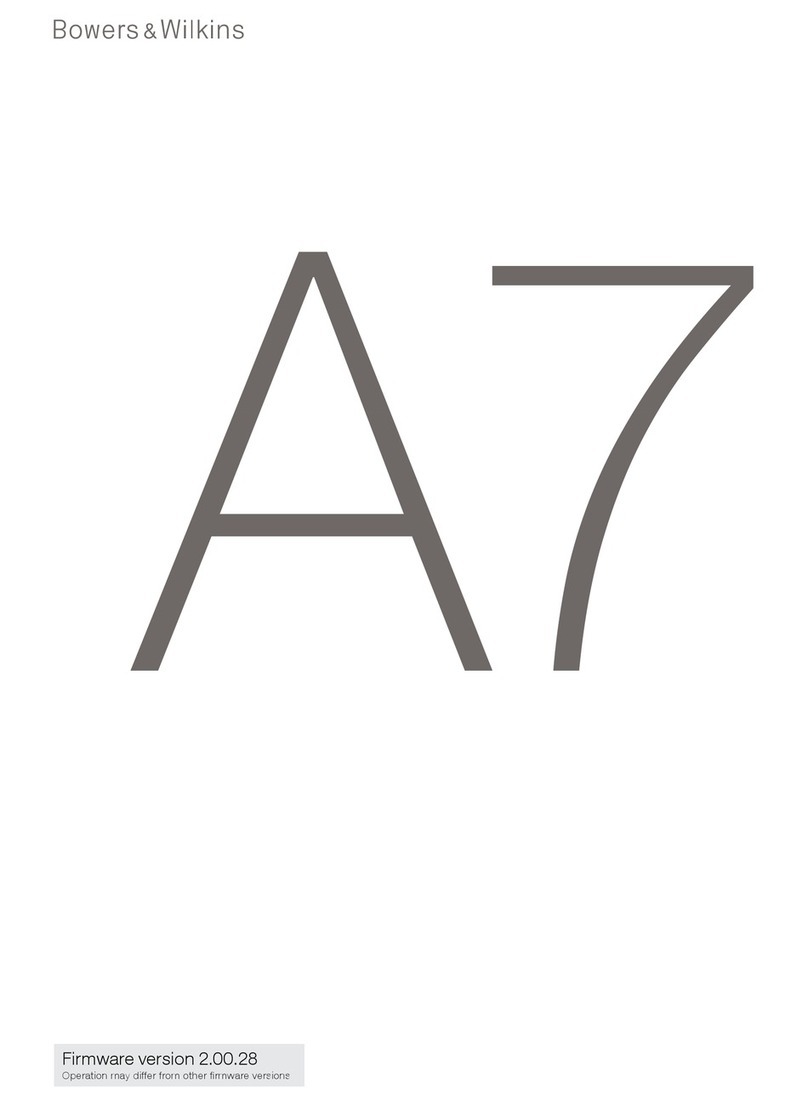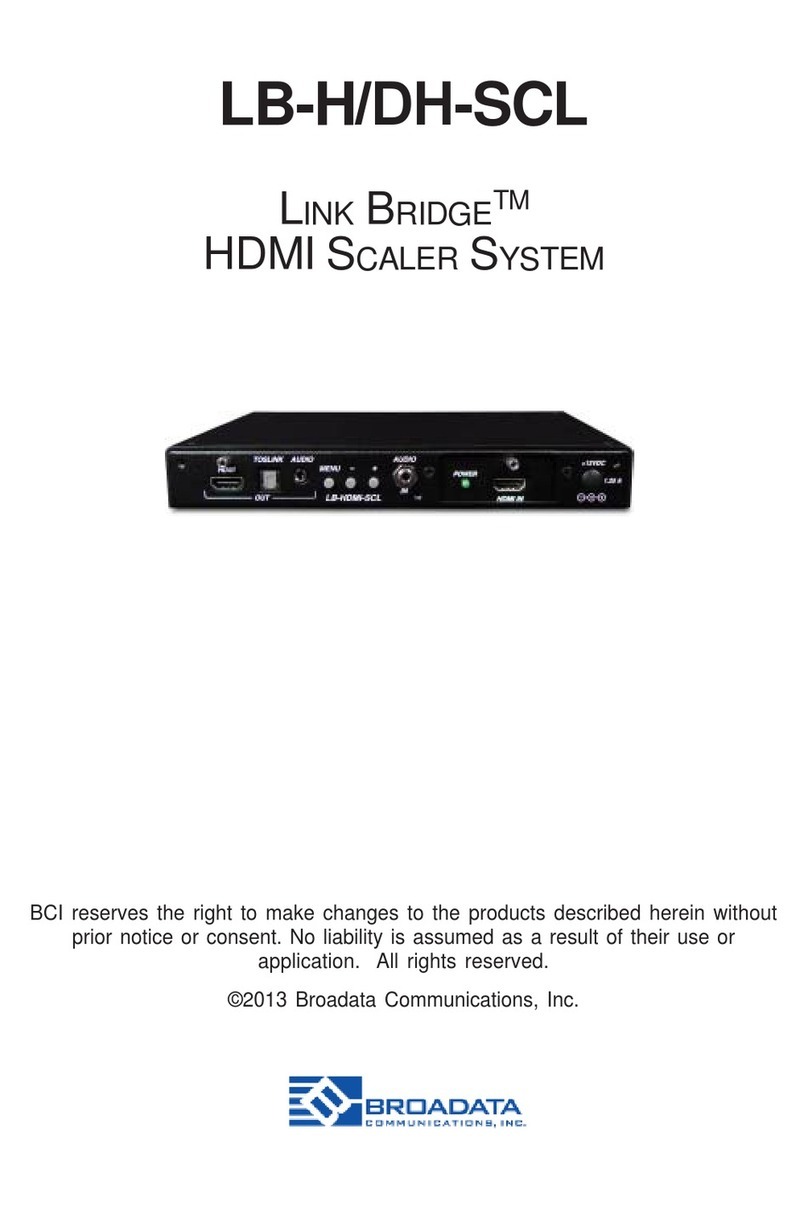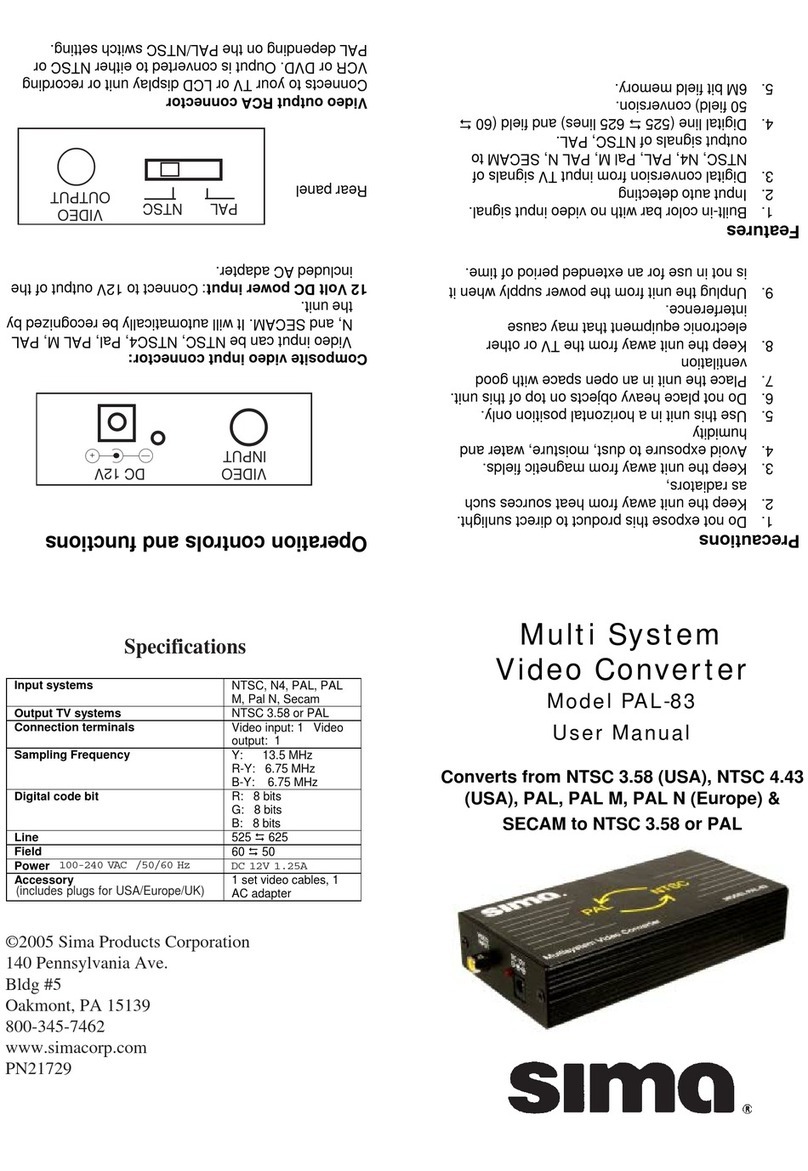FIAL 2310 AL User manual

MODEL 2310 AL
MCS-11 REMOTE ENCODER
FIAL INCORPORATED
710 Center Street
Oregon City, OR 97045
503.607.1940
WWW.FIAL.COM’
DOCUMENT NUMBER FC2310_AL-040506
COPYRIGHT © 2004 BY FIAL INCORPORATED

NOTICE OF FCC COMPLIANCE
NOTE
This equipment hasbeen tested andfound to complywith the limits for a Class A digital
device pursuant to Part 15 of FCC Rules. These limits are designed to provide reasonable
protection against harmful interference when thisequipment is operated ina commercial
environment. Thisequipment generates, uses,and canradiate radio frequencyenergy
and, if not installed andused in accordance withthe instruction manual, may cause harmful
interference to radio communication. Operation ofthis equipment in a residentialarea is
likely to cause harmful interference, in which casethe user will be required to correct the
interference at his/her own expense.

MODEL 2310 AL MCS-11 REMOTE ENCODER
FIAL INCORPORATED FC2310_AL-20040506 i
Table OF CONTENTS
BRIEF DESCRIPTION...................................................................................................................................................1
DETAILED DESCRIPTION............................................................................................................................................3
INSTALLATION.............................................................................................................................................................7
STATION GROUND JUMPER (STA. GND) CAUTION............................................................................................7
PROGRAMMING.........................................................................................................................................................13
REAL TIME MONITORING.........................................................................................................................................22
MCS-11 REMOTE ENCODER MODEL 2310 AL SPECIFICATIONS.....................................................25
MCS-11 REMOTE ENCODER CONNECTOR PIN ASSIGNMENTS........................................................27
APPENDIX A -- CONSIDERATIONS FOR TSM-2500/8000 CONFIGURATION.............................31
FIGURES
FIGURE 1. MODEL 2310 ALFRONT PANEL.............................................................................................................2
FIGURE 2. MODEL 2310 ALREAR PANEL................................................................................................................2
FIGURE 3. POSITIVE GROUND SYSTEM..................................................................................................................7
FIGURE 4. NEGATIVE GROUND SYSTEM.................................................................................................................7
FIGURE 5. BATTERY POLARITY SELECT FOR OPTOISOLATORS........................................................................8
FIGURE 6. DCE VERSUS DTE SELECTOR SWITCH ................................................................................................9
FIGURE 7. EXAMPLE OF HIGH-SPEED SYNCHRONOUS TO LOW-SPEED ASYNCHRONOUS SPUR.............10
FIGURE 8. EXAMPLE OF HIGH-SPEED ASYNCHRONOUS HOP ..........................................................................11
FIGURE 9. GENERAL PAGE (DEFAULT).................................................................................................................13
FIGURE 10. BRIDGE POLLS SELECTION...............................................................................................................14
FIGURE 11. RSS OR RDS PAGE..............................................................................................................................17
FIGURE 12. RCDI PAGE............................................................................................................................................19
FIGURE 13. RAS PAGE.............................................................................................................................................20
FIGURE 14. RDS PAGE IN MONITOR MODE...........................................................................................................22
FIGURE 15. RCDI PAGE IN MONITOR MODE.........................................................................................................23
FIGURE 16. RAS PAGE IN MONITOR MODE...........................................................................................................24

MODEL 2310 AL MCS-11 REMOTE ENCODER
ii FC2310_AL-20040506 FIAL INCORPORATED
TABLES
TABLE 1. MULTIPLIERS FOR MCS-11 MASTER CONFIGURATION.....................................................................4
TABLE 2. ANALOG INPUT ATTENUATION VERSUS FREQUENCY......................................................................6
TABLE 3. ADDITIONAL TIMES FOR ASYNC HOPS...............................................................................................12
TABLE 4. MCS-11 RS-422 PIN ASSIGNMENT (DB-15F).......................................................................................27
TABLE 5. MCS-11 RS-232 PIN ASSIGNMENT (DB-15F).......................................................................................27
TABLE 6. MCS-11 RS-232 PIN ASSIGNMENT (DB-15F).......................................................................................27
TABLE 7. RELAY OUTPUT CONNECTOR PIN ASSIGNMENTS...........................................................................28
TABLE 8. ALARM INPUT CONNECTOR PIN ASSIGNMENTS..............................................................................29
TABLE 9. ANALOG INPUT CONNECTOR PIN ASSIGNMENTS............................................................................30
TABLE 10. CRAFT INTERFACE PORT (RS-232) PIN ASSIGNMENTS.................................................................30

MODEL 2310 AL MCS-11 REMOTE ENCODER
FIAL INCORPORATED FC2310_AL-20040506 1
BRIEF DESCRIPTION
The Model 2310 AL is a remote alarm encoder for MCS-11 monitored systems. It can monitor 32
alarm points, control 16 on/off points, and (optionally) read up to 16 analog voltages. A Windows
program is used to configure the unit, via an RS-232 craft port interface.
The unit has two MCS-11 ports for remote monitoring. Both ports operate in DTE mode, while one
of the ports may be switched to either DTE or DCE mode operation. The 2310 AL always listens to
polls coming in from both MCS-11 ports and can be configured to answer polls in one of two ways.
If the 2310 AL receives a poll for its address, it can either send the answer out both ports, or send it
only out the same port on which its poll was received.
Both ports may be set to operate at either RS-422 or RS-232 interface levels. Each port on the
2310 AL may be configured for either synchronous or asynchronous clocking. This feature allows
MCS-11 network traffic to be carried via asynchronous RS-422 or RS-232 signaling. This may be
useful where synchronous MCS-11 channels are not available between radio hops.
The 2310 AL may also be configured to bridge MCS-11 packets, so that the unit acts like a two port
bridge for MCS-11 traffic. The bridging can be configured to include all addresses in the 128
station MCS-11 address range (typical), or to selectively specify the addresses to bridge, blocking
all others (useful with slow async spurs extending beyond the 2310 AL).
Existing configuration information can be uploaded from a 2310 AL via the craft port interface and a
Windows based user program. The 2310 AL can also monitor real-time alarm events with this
program, via the craft port, to aid a field technician in some troubleshooting situations.

MODEL 2310 AL MCS-11 REMOTE ENCODER
2 FC2310_AL-20040506 FIAL INCORPORATED
The Model 2310 AL MCS-11 Remote Encoder includes front panel LED indicators for power, unit
fail, summary alarm and MCS-11 data and clock signals. It also includes 32 front panel alarm point
indicator LEDs. These LEDs display the current status of the unit’s associatedRSS or RDS alarm
points. The 32 alarm LEDs are arranged in 2 rows of 16 LEDs each.
Figure 1. Model 2310 AL Front Panel
Figure 2. Model 2310 AL Rear Panel
Pressing the LAMP TEST button on the 2310 AL turns on all front panel LEDs, verifying proper
operation of the lamps. There is also an additional function for this button. Pressing and holding
the LAMP TEST button for over three seconds changes the front panel alarm LED display to
indicate the current state of theinternal control relays. Control relays that arecurrently asserted
(ON) will have their corresponding front panel LED on. There are only 16 control relays, soonly
the first 16 (top row) LEDs are used to indicate control relay states. Releasing the LAMP TEST
button returns the alarm LEDs to their normal function.
The Model 2310 AL may be powered by 24 or 48 volt station battery, without any switch or jumper
changes necessary. It mounts in a 19-inch rack, and is 1U high.

MODEL 2310 AL MCS-11 REMOTE ENCODER
FIAL INCORPORATED FC2310_AL-20040506 3
DETAILED DESCRIPTION
ALARM INPUTS: The 32 alarm inputs are optically isolated. Alarm inputs can be asserted by
connecting the input to station ground or by removing ground from the input. Alarm inputs can be
delayed before asserting an alarm. The external switching device must handle a current of 2
milliamperes. The alarm inputs are scanned every 200 milliseconds. The 32 points are
addressable as a set to the Remote Station Scanner (RSS) or any one of the MCS-11 Remote
Detail Scanners (RDSs). When the alarm points areplaced inan RDS, an RSS summary point
may be configured to assert when any of the RDS alarm points are asserted. This summary point
may be placed in any one of the 32 RSS point positions. A normally open relay output may be
configured to close whenever this summary point is asserted. The alarm input connectoris a
female 50-pin CHAMP on the rear panel.
RDS pointsin alarm can onlyaffect asummarybit if the RDS issummarized to an RSS point
(recommended). If you do not map the RDS to a summary point, then RDS alarms in the 2310 AL
will not get polledby the MCS-11 monitoring system unless theRDS is in RapidPoll or Cyclic Poll.
If the alarm points aremapped to an RDS, and the summary point forthe RSS is set to NONE,
then the 2310 AL will not answer RSS polls. This is useful in cases where an RSS already exists
at a site, and you just want to add an RDS using the 2310 AL Encoder. In this case, the summary
relay contacts can be used to set a summary bit in the existing RSS (hard-wired from the 2310 AL
to the radio). Note that the summary relay will be closed when an alarm point is set. It will not be
closed if status points are set.
ALARM POINT VS STATUS POINT: Each of the 32 inputs may be configured to be an alarm
point or a statuspoint. Once asserted, analarm point is latched until read (polled). Statuspoints
are not latched -- the state of the point in the scanner changes in real-time with the state of the
input pin. Also, if the 32 points are mapped to an RDS scanner, then a summary point may be set
whenever one or more alarm points are asserted. Summary points are never affected by the state
of a status point.
DELAYED ACTIVATION: Each of the 32 inputs may have a delay associated with it. This is
useful when you want to ignore short, intermittent events. The delay may be set from one second
up to about 18 hours. For example, if an input has a 10 second delay set, then the point must be
continuously asserted (uninterrupted) at the input pin for a minimum of 10 seconds before the
alarm point is set in the scanner.
CONTROL OUTPUTS: The 16 control outputs are derived from relays with form-C contacts
(normally open, common, andnormally closedcontacts). The form-C contacts allow the power-off
default to be wired as normally off or normally on. The 16 control points are addressable as a set
to any one of the 6 MCS-11 Remote Control Decoder Interfaces (RCDIs). The relay output
connector is a female 50-pin CHAMP mounted on the rear panel. The contacts are rated for 1
Amp up to 48 volts DC, 0.6 Amps at 110 volts DC, and 0.6 Amps at 125 volts AC.
The default mode of operation for the control point is ON/OFF. An MCS-11 ON command will

MODEL 2310 AL MCS-11 REMOTE ENCODER
4 FC2310_AL-20040506 FIAL INCORPORATED
close the relay, and an MCS-11 OFF command will open the relay. The configuration program
also allows you to make any of the outputs act in a momentary fashion. If momentary is selected,
then the relay is operated for 200 milliseconds for each MCS-11 ON command. MCS-11 OFF
commands are ignored for points selected as momentary. You may set the amount of time that a
momentary control point (status) is reported as ON using the configuration program.
ANALOG INPUTS: An optional analog input card is available. This card provides 16 voltage-
measuring inputs that can be mapped as a set to any one of the RAS scanners. Each input can be
set to any one of the ten input ranges in Table 1 below. MCS-11 Remote Analog Scanners (RASs)
can contain up to 24 values, and each value can range from 000 to 999. An input voltage equal to
the maximum of the range selected will cause the analog scanner value to be set to 999.
Table 1 below lists these values to the precision required. The values in the right column of the
table represent the multiplier constant to be used in configuring an MCS-11 master, such as the
NGM, TSM-8000, TSM-2500, TSM-3500, DCP-1500, etc. The MCS-11 master will multiply each
RAS value by the multiplier you set in order to convert the value to the proper range of counts (the
typical units setting is ‘voltage’). You will need to enter the proper multiplier for each analog point
into the master so that it can display the counts from the 2310 AL properly. Note that for negative
input ranges, the multiplier is a negative number.
Input range Multiplier to
scale MCS-11
zero to 999
range to volts
0 to +7.5 volts 0.0075075
0 to +15 volts 0.015015
0 to + 30volts 0.03003
0 to +60 volts 0.06006
0 to +120 volts 0.12012
0 to -7.5 volts -0.0075075
0 to -15 volts -0.015015
0 to -30 volts -0.03003
0 to -60 volts -0.06006
0 to -120 volts -0.12012
Table 1. MULTIPLIERS FOR MCS-11 MASTER CONFIGURATION
The analog inputs are generally measured relative to a common ground. However, pairs of inputs
may be set to differential input mode. In differential mode, the measurement is made between the
two inputs of the pair, rather than between an input and ground. If input 1is set to differential
mode, then input 9automatically becomes the other input of the pair. In this case, point 1 in the
RAS will hold the differential value, but point 9 will alwayshave a 000 value. If input 2is set to
differential mode, then input 10 becomes the other input of the pair, and so on. The configuration

MODEL 2310 AL MCS-11 REMOTE ENCODER
FIAL INCORPORATED FC2310_AL-20040506 5
program allows you to choose single-ended vs. differential mode for each pair of points.
The last point in the RAS (point 24) is used to indicate failure of the analog input subsystem.
A 000 in point 24 indicates normal operation. A 999 in point 24 indicates that the analog input card
is not responding to requests from the 2310 AL main processor. The master should map point 24
as an 'analog input fail' alarm point when its value is above zero.
The resistance for each analog input is 52,000 Ohms between the input and ground. Other values
are available up to 600,000 Ohms (please consult the factory at time of order).
Each analog input is RC lowpass filtered in order to reject higher frequencies. The time constant is
approximately 0.05 seconds. The attenuation versus frequency is as follows:

MODEL 2310 AL MCS-11 REMOTE ENCODER
6 FC2310_AL-20040506 FIAL INCORPORATED
Frequency Attenuation
DC (0 Hertz) 0x
5 Hz 1.6x
10 Hz 2.8x
20 Hz 4.1x
60 Hz 14.5x
120 Hz 29.2x
240 Hz 58.3x
1000 Hz 175x
Table 2. ANALOG INPUT ATTENUATION VERSUS FREQUENCY
Shielded wire is recommended forconnecting distant measuring points to the input connector, and
shielded pair cable is recommended for connecting differential inputs to the input connector.
MCS-11 COMMUNICATIONS PORTS: The 2310 AL MCS-11 Remote Encoder has two MCS-11
communications ports available at two DB-15 female connectors on the rear of the unit. The ports
are labeled MCS-11 Port 1 and MCS-11 Port 2.
Each MCS-11 port can be configured for either RS-422 or RS-232 interface levels, and for either
synchronous or asynchronous modes of operation. Synchronous mode uses separate signals for
transmit data, receive data, transmit clock, and receive clock. Asynchronous mode only uses the
transmit data and receive data signals, it does not use separate clock signals.
In synchronous mode, Port 1 is strictly a DTE port. This means it accepts transmit and receive
clocks from another unit. Port 2 can be set to either DTE (accepts clock) or DCE (generates clock)
mode. DCE mode is only allowed for synchronous RS-422. The RS-232 interface is always DTE.
In asynchronousmode, both Port 1 and Port 2 are considered DTE ports. Either port may be set to
RS-422 or RS-232 interface levels. For asynchronous RS-422 mode, only transmit data and
receive data signals are used (1 pair of wires per signal). In asynchronous RS-232 mode, only
transmit data, receive data, and ground are used (1 wire per signal).
The DTE vs. DCE selection is made via the configuration program and additionally, an internal
slide switch. The cover must be removed to gain access to this switch. The configuration
program also sets the clock rate for DCE operation.
The unit always listens for polls on both of the ports and when polled, will either answer out the
receiving port only, or out both ports, as configured by the user. The unit can be configured to
bridge ALL, or a selected set, of MCS-11 polls and answers between the two ports. For all
addresses specified for bridging, all polls and answers received at either MCS-11 port are re-
transmitted out of the other MCS-11 port.

MODEL 2310 AL MCS-11 REMOTE ENCODER
FIAL INCORPORATED FC2310_AL-20040506 7
INSTALLATION
Install this unit in 24 or 48 volt positive ground or negative ground stations. The factorydefault is
positive ground operation. Power is connected to a 2-terminal barrier strip at the rear of the unit.
Mounting ears are supplied for flush or projection mounting in a 19-inch rack.
There is an external chassis ground wire (jumper) that must be connected to the station ground
terminal at the power input connector. For positive ground systems (factory default), the jumper
should connect between the chassis(labeled Sta. Gnd) and the positive power input terminal. For
negative ground systems, the jumper should connect between the chassis (labeled Sta. Gnd.) and
the negative power input terminal. This jumper is required for proper operation - it insures that the
unit's electrical (chassis) ground is connected to the station ground.
CAUTION: If connected incorrectly, there will be a short across the station battery!
STATION GROUND JUMPER (STA. GND) CAUTION
Some telecom sites require the station battery to be grounded at only one place near the battery
bank. If your installation requires an isolated station battery input, you must remove the provided
STATION GROUND jumper from the POSITIVE terminal of the power input terminal block on the
rear of the unit and provide an alternate connection from this STA. GND terminal to station ground.
The best way of providing a proper ground to the unit is to lengthen the jumper connected to STA
GND and securely connect it to the rack ground. Use a longer wire and a crimp/splice connector if
necessary. Leave the jumper connected to the STA. GND terminal (terminal block mounting screw
- right side). Do not loosen or remove the mounting screw securing the STA. GND jumper to the
terminal block, since it is secured with a washer and nut inside the unit.
Do not attempt to operate the equipment without a station ground (STA. GND) connection as
electrical damage may occur. The unit’s rack mounting screws alone will not provide a reliable
rack ground.
Figure 3. POSITIVE GROUND SYSTEM Figure 4. NEGATIVE GROUND SYSTEM

MODEL 2310 AL MCS-11 REMOTE ENCODER
8 FC2310_AL-20040506 FIAL INCORPORATED
There is an internal jumper (see Figure 5) which selects the negative or positive lead of the battery
input to power the alarm input optoisolators. For positive ground systems (factory default) the
jumper should be in the - Station Battery position. This selects the proper polarity voltage input to
power the optoisolators. For negative ground systems, the jumper must be in the + Station
Battery position. If this jumper isin the wrong position, an alarm input will not be asserted when
the input is connected to station ground.
Figure 5. BATTERY POLARITY SELECT FOR OPTOISOLATORS
ALARM INPUTS: You will need a 50-pin male ribbon connector (Amp CHAMP type) for the 32
inputs. It is best to order a pre-assembled cable assembly from a company such as Grayhill. One
easy option is to use a cable with a 50-pin connector at one end and a 66 block (punch-down
block) at the other end. The punch down block can be mounted on the wall, and all the station
alarms brought to that block. The pin assignments for the I/O connectors are detailed at the end of
this document.
CAUTION: The alarm input connector pin assignments do NOT follow typical Telco pin pairing.
There are not enough pins to allow each of the 32 alarm points to have a separately paired ground
wire. Follow the pin assignments for the connector detailed at the end of this document (Table 8).
RELAY OUTPUTS: You will need a 50-pin male ribbon connectorfor the 16 form-C relay outputs
(Amp CHAMP type) for the outputs. It is best to order a pre-assembled cable assembly from a
company such as Grayhill. One easy option is to use a cable with a 50-pin connector at one end
and a 66 block (punch-down block) at the other end. The punch down block can be mounted on
the wall, and all the outputs can be connected at that point.
CAUTION: The relay output connector pin assignments do NOT follow typical Telco pin pairing.
There are not enough pins to allow each of the NormallyOpen & Normally Closed contacts of the
16 control relays to have a separately paired ground wire. Follow the pin assignments for the
connector detailed at the end of this document (Table 7).
ANALOG INPUTS: A single DB25 female connector is used for the analog inputs. Its pin
assignments are detailed in Table 9. These inputs will not be functional unless the optional analog-

MODEL 2310 AL MCS-11 REMOTE ENCODER
FIAL INCORPORATED FC2310_AL-20040506 9
input board is installed in the unit. The connector has separate pins for station ground and analog
ground. These are connected together at the 'common' measurement point on the analog board.
Single ended measurements may be connected between an analog input pin and either station
ground or analog ground. For the most accurate measurements, a pair of wires should run from
the device being measured to the model 2310 AL, with the 'ground' wire connected to an analog
ground pin and the active wire connected to the analog input pin. A shielded wire is recommended
for electrically noisy environments, and a shielded pair is recommended for differential input
measurements.
The analog inputs are low pass filtered. There is no attenuation for frequencies below 1 Hertz. A
60 Hertz signal is attenuated 14.5 times relative to DC. See Table 2 on page 6 for attenuation data
for other frequencies.
Configuring the 2310 AL (with either the craft port interface or Windows programs) to report MCS-
11 analog scanner points without having installed an analog-input board is an error condition. This
error causesthe front panel Unit Fail LED to blink three times, pause, thenrepeat.
MCS-11 PORTS: There are two MCS-11 ports on the back of the unit. You may select RS-422 or
RS-232 operation for each port with the configuration software. For RS-422 operation, both MCS-
11 ports can be operated as DTE (accepting clock from other units). In addition, MCS-11 Port #2
can be changed to DCE (providing clock to other units). If DCE operation is selected in the
configuration program, the unit's cover must also be removed and an internal slide switch (S1)
operated. This switch setting MUST match the setting downloaded from the configuration program.
The configuration program is used to set the DTE / DCE mode and the clock rate for the DCE port.
Figure 6. DCE VERSUS DTE SELECTOR SWITCH
The configuration software can also select the addresses to bridge across the MCS-11 ports. If
any addresses have been specified forbridging, then MCS-11 polls and answers for those selected
addresses, arriving at either MCS-11 port, are re-transmitted out the other MCS-11 port. The unit
may also be configured to either send out its own answers (replies to polls) on both ports, or only
on the port from which the poll was received. The typical setting for synchronous MCS-11 protocol

MODEL 2310 AL MCS-11 REMOTE ENCODER
10 FC2310_AL-20040506 FIAL INCORPORATED
is to always send the answers to polls out both ports.
Special conditions may require that the 2310 AL send answers to polls for itself only out the
receiving port. This might apply to a situation where the 2310 AL is part of a spur, with one port set
for a high-speed synchronous connection to the backbone, and the other port set for a slow-speed
asynchronous link to the spurradios. You may not want to incur the delay of sending answers to
polls out the slow-speed downstream link, if the poll only comes in on the high-speed port. In this
situation you would configure the unit to not send its answer out both ports, and to only bridge
polls for the station addresses of any downstream spur radios across to the other port. This keeps
the number of slow-speed packets to a minimum.
NOTE: Configuring a 2310 AL to only send its answer out on the port from which it was received,
or to block certain MCS-11 station addresses from being bridged, does not strictly follow the MCS-
11 protocol. Setting these options means that not all data packets would be visible if monitored at
the far end of the radio hop or spur. There might be other equipment (such as multi-mastered
polling engines, 5100 Test Sets, etc.) downstream from the 2310 AL that need to monitor all polls
and answers, from all station addresses in the network. You would typically configure the 2310 AL
to bridge all station addresses and send answers to polls out both ports in this situation.
Figure 7. EXAMPLE OF HIGH-SPEED SYNCHRONOUS TO
LOW-SPEED ASYNCHRONOUS SPUR
If you have a 2310 AL RTU configured to bridge through to a low-speed asynchronous spur (with
nothing monitoring the system from the end of the spur), you could configure the 2310 AL to
minimize the delays incurred by bridging unnecessary data packets through the low-speed spur
section.
Async
Radio
Sync
Radio
RSS
A13
Sync Port Async Port
2310 AL RTU
RSS C11
Async
Radio
Async
Radio
Async Port Async Port
2310 AL RTU
RSS C12
Async
Radio
Async Port
2310 AL RTU
RSS C13
Site One Site Two Site Three
Low-Speed Async Low-Speed Async
High-Speed
Sync

MODEL 2310 AL MCS-11 REMOTE ENCODER
FIAL INCORPORATED FC2310_AL-20040506 11
In the example in Figure 7, if the 2310 AL RTU at Site One (addressed as C11) were configured to
not answer on both ports and to block all addresses except C12 and C13, then the only traffic
across the low-speed asynchronous link would be the polls and answers for addresses C12 and
C13. All other polls and answers would not be passed through the first 2310 AL and on to the
spur.
Figure 8. EXAMPLE OF HIGH-SPEED ASYNCHRONOUS HOP
In the example in Figure 8, two 2310 AL RTUs are used to provide an asynchronous link between a
section of a high-speed synchronous radios. The speed of the asynchronous link depends only on
the capabilities of the transport mechanism. The 2310 AL can support asynchronous speeds from
1200 to 19200 bps. Always use the highest asynchronous speed possible. Using speeds that are
too low may require adjustments to timeout and poll response delay settings in other equipment on
the network and may seriously affect system response. You would typically configure each 2310
AL to bridge all station addresses and send answers to polls out both ports in the above example.
For networks monitored by multiple masters (polling engines), 5100 Test Sets, or in a ring
configuration, a slow-speed asynchronous hop may cause data packets to be lost unless Polling
Engine parameters are set to accommodate the slower response times.
When using the 2310 AL for asynchronous hops across an MCS-11 synchronous network, or on a
spur, you shouldadjust yourAE-36S-X or 260X PollingEngine poll response time-out andinterpoll
delay settings. This is necessary to allow packets to finish transmission before the next packet
arrives, and to allow for the added delay in getting responses back.
Sync
Radio
RSS
A14
Async
Radio
Async Port Sync Port
2310 AL RTU
RSS C12
Site One Site Two Site Three
Async
Radio
Sync
Radio
RSS
A13
Sync Port Async Port
2310 AL RTU
RSS C11
Sync
Radio
RSS
A16
Sync
Radio
RSS
A15
Sync Port Sync Port
2310 AL RTU
RSS C13
High-Speed Async High-Speed Sync

MODEL 2310 AL MCS-11 REMOTE ENCODER
12 FC2310_AL-20040506 FIAL INCORPORATED
The table below offers suggested times to be added to the Polling Engine poll response time-out
and interpoll delay settings for different asynchronous baud rates. Take the time from the table,
multiply by each 2310 AL in the path configured for asynchronous communication, then add the
total to the current Polling Engine poll response time-out and interpoll delay settings.
Baud Rate Add to PE
Poll Response Time-Out
and Interpoll Delay
1200 320 ms
2400 160 ms
4800 80 ms
9600 40 ms
19200 20 ms
Table 3. ADDITIONAL TIMES FOR ASYNC HOPS
Two 15-pin DB-15 female connectors are used for the MCS-11 ports. If you are connecting to
MCS-11 RS-422 equipment, the best type of cabling to use would be twisted pairs. The pairings
for these MCS-11 ports are: Pin 1 with pin 9; pin 2 with pin 10; pin 3 with pin 11; pin 4 with pin 12;
pin 5 with pin 13; and pin 6 with pin 14. Pin 15 is unused.
CRAFT INTERFACE: The craft interface port is for atemporary connection to a PC Com port.
This port is used to download a new configuration to the unit, upload an existing configuration from
the unit, or to monitor real-time alarm conditions for troubleshooting. The included Windows
program performs all of these operations.
A single DB-9 female connector is used for the craft port interface. The pin assignments permit a
direct connection to a 9-pin PC COM port. A straight-through connected cable with 9 wires will
work, however only 3 wires are required. The cable will require a male DB-9 at the 2310 AL end,
and (usually) a female DB-9 at the computer end. The pin assignments are detailed in Table 10 on
page 30.

MODEL 2310 AL MCS-11 REMOTE ENCODER
FIAL INCORPORATED FC2310_AL-20040506 13
PROGRAMMING
An included Windows based program is used to configure the MCS-11 Encoder. The configuration
data is transferred between the PC and the MCS-11 Encoder's craft port using COM 1, 2, 3, or 4.
To install the software, simply copy the file named "FC2310.exe" from the supplied floppy disk to
your hard disk, or run the program directly from the floppy disk.
Enter the appropriate configuration settings as described below. When you run this program, the
following main screen appears:
Figure 9. GENERAL PAGE (DEFAULT)
The program has a set of four tabs that you may use to select different views or'pages'. The first
page is called General, and is concerned with configuration settings that apply to the Model 2310
AL unit as a whole. The following sections explain each setting.
MCS-11 ALARM ENCODER STATION ADDRESS: The Station address desired for the 2310 AL
must be set properly. The address range is Athrough Hand 1through 16 (128 possible
addresses). Note: Address H16 should not be used if you are planning to use multiple MCS-11
polling engines with poll synchronization.

MODEL 2310 AL MCS-11 REMOTE ENCODER
14 FC2310_AL-20040506 FIAL INCORPORATED
BRIDGE MCS-11 PORTS: You must push the Bridge MCS-11 Ports button if you want MCS-11
polls and answers to be bridged (passed through) between MCS-11 ports one and two. The
default condition is to block (not bridge) all addresses. Pressing the Bridge MCS-11 Ports button
opens the Bridge Polls dialog window (see Figure 10).
This dialog window allows you to select some, or all, of the available MCS-11 addresses to bridge
through the 2310 AL. Addresses in the left pane are blocked, and addresses in the right pane are
bridged. Polls and answers received on one port for any bridged address are passed through to
the other port. Highlight the desired addresses (using standard Windows techniques) and press
the single arrowhead buttons to move the selected addresses from one pane to the other. Use the
double arrowhead buttons to move ALL entries (highlighted or not) from one pane to the other.
Press the OK button to accept the settings.
Figure 10. BRIDGE POLLS SELECTION
There is a status line immediately to the right of the Bridge MCS-11 Ports button that indicates the
current bridging condition, see Figure 9. This line will read either ‘No Bridging (All Addresses
Blocked)’, or ‘Bridging (1 or More Addresses Bridged)’.
ANSWER RSS POLLS: This box must be checked if you want to respond to polls for the RSS of
this unit’s station address. If you have assigned alarms to an RDS and set an RSS summary point,
then this box is automatically checked and grayed out. If you assign the unit alarm points to an
RDS and do not select an RSS summary point, the Answer RSS Polls checkbox is automatically
unchecked and grayed out. If the Answer RSS Polls box is not checked, then theunit will not
answer polls for this station address RSS. This box would not be checked if you already have an
RSS responding at the site using the same MCS-11 address as the 2310 AL, and are 'overlaying'
additional RDS scanners at that address. The summary relay contact may then be used to assert
a summary bit in the pre-existing RSS. See appendix A if you are not checking this box.

MODEL 2310 AL MCS-11 REMOTE ENCODER
FIAL INCORPORATED FC2310_AL-20040506 15
SEND ANSWER OUT BOTH PORTS: This box must be checked if you want the 2310 AL to send
its answers to polls out both MCS-11 ports. If you only want the unit to respond to polls for its
address only on the same port on which the poll was received, then leave this box unchecked.
This option has nothing to do with the Bridge/Block option mentioned earlier. Even if you have the
RSS address of the 2310 AL blocked (set to not be bridged), you canstill set the unit to sendits
answers out of both MCS-11 ports with this option.
NUMBER OF SECONDS TO SHOW MOMENTARY ASSTERTION: This entry field lets you
specify the number of seconds that the RCDI status shows a momentary point to be ON after a
momentary ON command. The relay will close for only 200 milliseconds, but you may wish the
RCDI status for the relay to show the ON event for 30 seconds or more, such that an operator gets
feedback of the ON event. This setting works in conjunction with the two radio buttons below.
HOLD MOMENTARY STATUS FOR FULL TIME: Any 2310 AL control point may be configured
for momentary mode, where an MCS-11 ON command closes the associated relay for 200
milliseconds. This is too short a time for many MCS-11 masters to read the RCDI status and see
that the relay actually operated. If you click on this radio button, the status of momentary control
points will remain ON for the entire time set in the Number Of Seconds To Show Momentary
Assertion box.
HOLD ONLY UNTIL STATUS POLLED: If youclick on this radio button, then thecontrol point ON
status will be cleared after the first 'read' of the statusscanner by the master. The status will be
cleared even if the total number of seconds set in the Number Of Seconds To Show Momentary
Assertion box hasnot yet passed. In that case, the MCS-11 master will see the control point status
as ON forthe first poll, then OFF with thenext poll.
POLL-RESPONSE DELAY: This value should be set to 10 to 15 milliseconds fora typical MCS-
11 system. This insures that MCS-11 equipment that bridge traffic have cleared and are ready for
the response.
COM PORT: Choose the PC COM port which you will use to connect to the 2310 AL for download
and upload of the configuration parameters, and to monitor real-time alarm events.
PORT 1 INTERFACE: Selects MCS-11 Port 1 physical protocol. Choose RS-422 or RS-232
operation. RS-232 is generally used only for connecting to synchronous modems. RS-422 is
generally required or preferred for everything else.
PORT 1 CLOCKING: Selects MCS-11 Port 1 clocking. Choose from either Synchronous or
Asynchronous modes. Typical MCS-11 systems use Synchronous clocking, where there are
separate transmit and receive data and transmit and receive clock signals. Clock signals are
provided by the DCE device.
Some special situations may require use of Asynchronous mode. Asynchronous mode only uses
transmit and receive data signals. Separate transmit and receive clock signals are not used in
asynchronous mode.

MODEL 2310 AL MCS-11 REMOTE ENCODER
16 FC2310_AL-20040506 FIAL INCORPORATED
CHOOSE BAUD RATE OF PORT 1: Use this drop-down list box to select the MCS-11 Port 1
clock rate. This list box only appears when Asynchronous clocking mode is selected.
PORT 2 INTERFACE: Selects MCS-11 Port 2 physical protocol. Choose RS-422 or RS-232
operation. For RS-422 operation, you may choose either DTE (port accepts clock) or DCE (port
generates and outputs clock) operation. If DCE is chosen, then a selection box appears which
allows you to choose the clock rate. Set the DTE / DCE slide switch appropriately -- see Figure 6.
PORT 2 CLOCKING: Selects MCS-11 Port 2 clocking. Choose from either Synchronous or
Asynchronous modes. Typical MCS-11 systems use Synchronous clocking, where there are
separate transmit and receive data and transmit and receive clock signals. Clock signals are
provided by the DCE device.
Some special situations may require use of Asynchronous mode, where the clock rate is set (the
same) at both DTE and DCE devices. Separate transmit and receive clock signals are not used in
asynchronous mode.
CHOOSE BAUD RATE OF PORT 2: Use this drop-down list box to select the MCS-11 Port 2
clock rate. This list box only appears for RS-422 DCE Synchronous mode, and for any
Asynchronous clocking mode selection.
FIRMWARE VERSION: This area displaysthe 2310 AL firmware (internal software) version. This
information is obtained from the unit before a download or upload session. Mismatched
configuration software and unit firmware versions will not communicate properly. This display is for
informational purposes.
DOWNLOAD BUTTON: This button downloads the current configuration to a 2310 AL device. If
the cable to the craft port is not connected or the 2310 AL is not responding, a ‘Port Time Out’
message appears. The 2310 AL must be powered up, but it is not required to have connections to
any ports other than the craft interface. A warning box appears to remind you to throw the internal
DTE / DCE switch to the proper position, depending on the configuration setting chosen. Make
sure to set the internal slide switch to either DTE or DCE to match the configuration program
setting for the 2nd MCS-11 port. After a successful download, the 2310 AL automatically resets.
UPLOAD BUTTON: This button uploads the current configuration from a 2310 AL device. All
settings in the Windows program are reset to match those of the 2310 AL. This option is useful if
you do not have access to the saved configuration disk file forthat unit.
SAVE AND LOAD BUTTONS: These buttons allow you to save a configuration to a disk drive and
then to re-load the configuration later. It is recommended that all configurations be saved with a
name that matches the station address used in that configuration. This allows configurations to be
checked at a latertime if there is doubt as to a setting. You may choose any file name you desire
for these files, however a .cfg extension is automatically added.
Table of contents
Other FIAL Media Converter manuals
